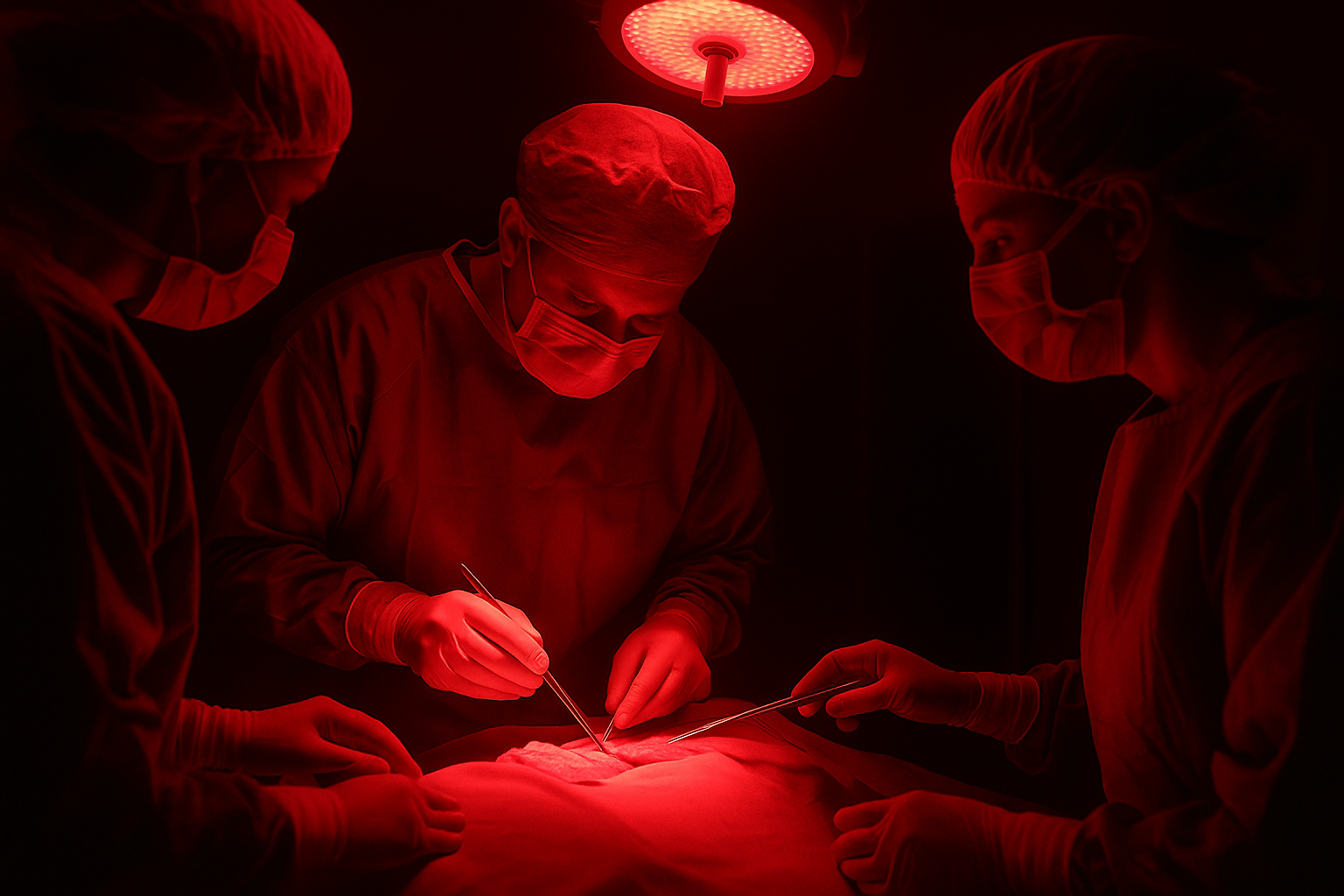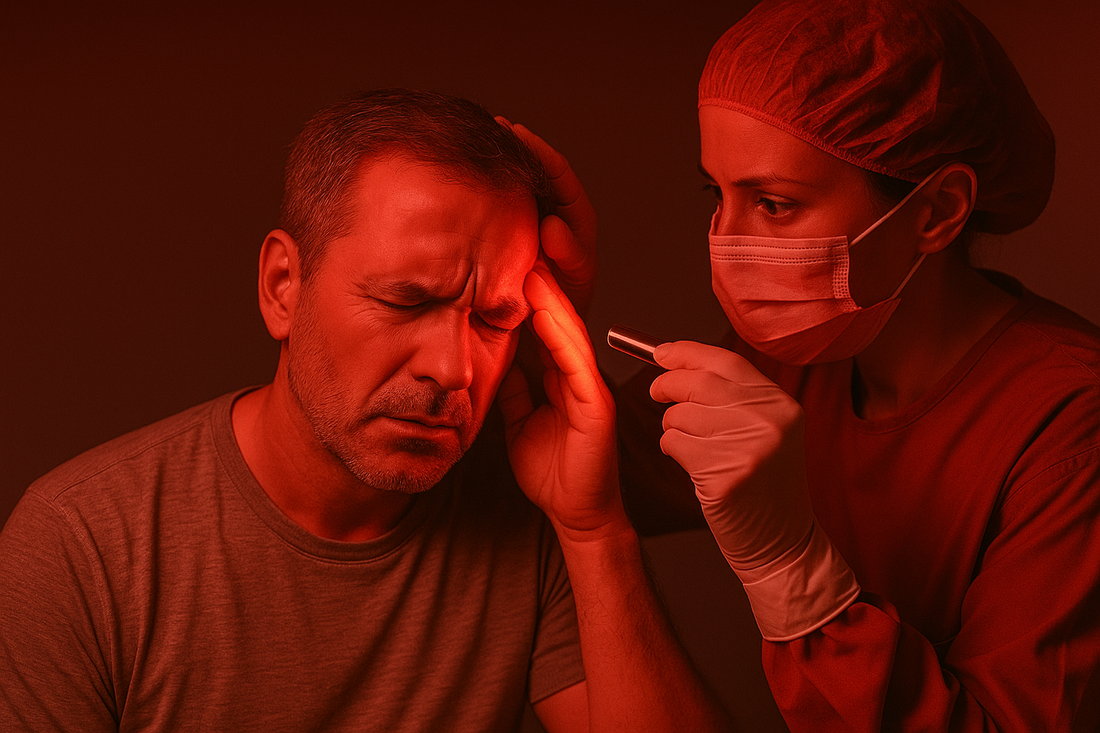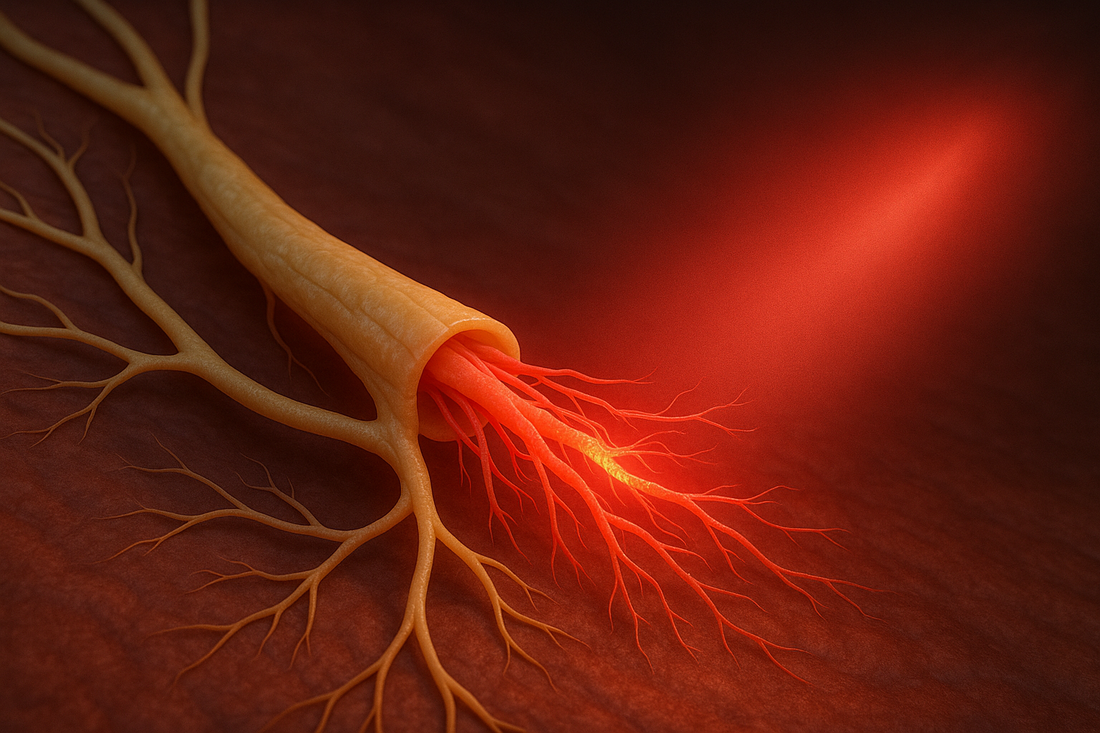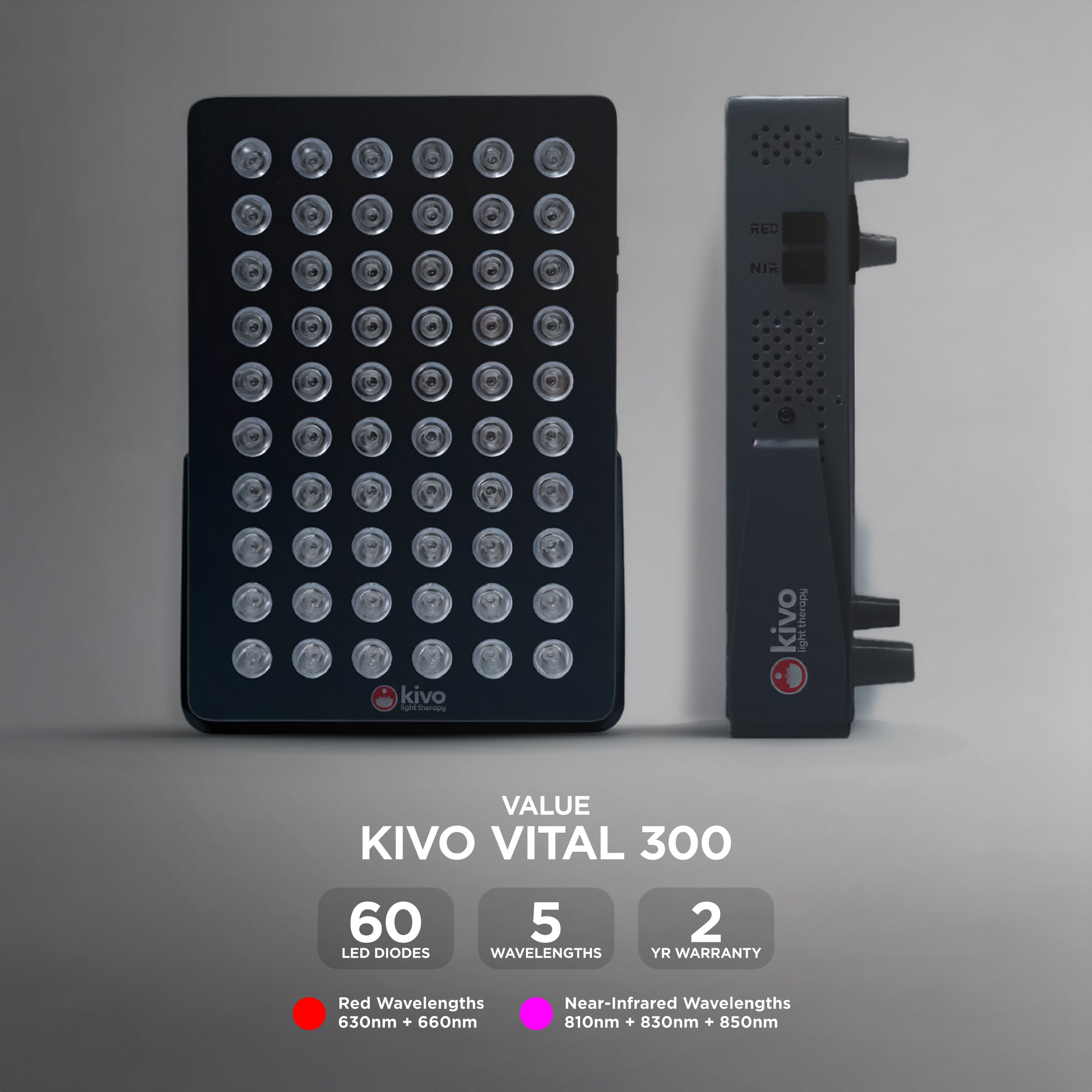In modern surgery, the focus is not only on the technical success of the procedure itself, but also on minimizing complications, speeding recovery, reducing pain, and achieving optimal functional and cosmetic outcomes. Advances in perioperative care - nutrition, pharmacology, rehabilitation - have yielded significant gains. Yet one adjunct that is gaining interest is photobiomodulation therapy (PBM) using red and near-infrared (NIR) light.
Throughout this article, we will refer to “red light” (typically wavelengths in the ~600 - 700 nm band) and “near-infrared” (often ~700 - 1000+ nm), and use the umbrella term photobiomodulation (PBM) to denote therapeutic, non-thermal, low-level irradiation with light in these bands.
Mechanisms: How Red & NIR Light Work at the Cellular Level
To understand how photobiomodulation might help with surgery, it’s crucial first to understand plausible mechanisms. Over decades of preclinical and translational research, there are several mechanistic pathways:
1. Mitochondrial stimulation and increased ATP
One of the central proposed effects is that red/NIR photons are absorbed by mitochondrial chromophores, particularly cytochrome c oxidase (Complex IV of the electron transport chain). This leads to enhanced electron transport, increased mitochondrial membrane potential, and elevated production of adenosine triphosphate (ATP) in target cells.
When cells have more “energy,” they may better carry out repair, proliferation, migration, and other regenerative processes.
2. Modulation of reactive oxygen species and redox signaling
Beyond simply boosting ATP, PBM can induce a modest, transient increase in reactive oxygen species (ROS), which act as signaling molecules to activate downstream transcription factors (e.g., NF-κB, AP-1) and gene expression of cytoprotective, proliferative, and anti-inflammatory pathways.
These cascades can lead to increased expression of growth factors (e.g., VEGF), heat shock proteins, and other mediators of repair.
3. Anti-inflammatory effects
PBM is widely reported to downregulate pro-inflammatory cytokines (like TNF-α, IL-1β, IL-6) and upregulate anti-inflammatory factors, thereby moderating excessive inflammation and fostering a more favorable healing environment.
In the context of surgery, modulating the post-insult inflammatory response is a key control point: too much inflammation can impair healing; too little may lead to inadequate tissue remodeling.
4. Enhanced perfusion, angiogenesis, and microcirculation
Red and NIR light can stimulate nitric oxide (NO) release, resulting in vasodilation and improved microvascular blood flow in treated tissues. This increased perfusion supports oxygenation and nutrient delivery to healing tissues.
Additionally, some data suggest promotion of angiogenesis (new small vessel growth) mediated through growth factor pathways.
5. Accelerated cell proliferation, migration, and matrix remodeling
By stimulating fibroblasts, keratinocytes, endothelial cells, and other resident cells, PBM can enhance migration into the wound bed, proliferation, and extracellular matrix production (such as collagen).
This supports faster closure, re-epithelialization, and structural integrity of repaired tissue.
6. Scar modulation and reduction of fibrosis
Because PBM can influence the balance of collagen deposition vs. remodeling, and modulate TGF-β and fibroblast activity, it holds potential to reduce hypertrophic scarring or fibrosis in incisions or grafts.
In sum, these overlapping mechanisms make photobiomodulation a well-suited adjunct in the context of surgical stress, wound repair, and reconstruction.
The Rationale for Pre-Op (“Preconditioning”) Use of PBM
Much of the clinical and translational work in PBM has focused on postoperative or wound-healing settings. Growing studies examine preconditioning with light therapy. “Preconditioning” in this context refers to applying PBM before surgery, to prime tissues for better response to surgical stress, reduce oxidative and inflammatory damage, and improve resilience.
Here are key reasons why pre-operative PBM may be beneficial:
1. Enhanced cellular reserve and mitochondrial resilience
By stimulating mitochondria prior to surgical insult, the theory is that tissues may better withstand ischemia, reperfusion stress, oxidative bursts, and inflammatory insult that accompany anesthesia, tourniquets, electrocautery, or clamping.
2. Anti-oxidant priming
PBM may upregulate endogenous antioxidant defenses (e.g., superoxide dismutase, glutathione peroxidase) ahead of surgical trauma. This can buffer reactive species generated intraoperatively. Some animal studies show that preoperative low-level laser can reduce markers of oxidative damage post-surgery (though clinical human data is sparse).
3. Reduced baseline inflammation or “priming modulation”
In patients with chronic low-level inflammation (e.g., due to obesity, metabolic syndrome), applying PBM prior to surgery might nudge the inflammatory milieu to a more favorable baseline, reducing exaggerated post-surgical inflammation.
4. Improved local perfusion and tissue quality
Preconditioning with PBM might boost microcirculation in tissues destined to be incised, grafted, or manipulated, improving baseline oxygenation and nutrient supply, which can help early healing.
5. Pre-emptive analgesia and neuromodulation
Some studies of PBM for pain suggest it can modulate nociceptors. Pre-op treatment might reduce perioperative nociceptive priming and lower analgesic needs after surgery.
In clinical practice, such “conditioning” is analogous to ischemic preconditioning, remote ischemic conditioning, and other strategies used in cardiac surgery or transplantation.
However, human clinical evidence for pre-operative PBM is still emerging. A review on “Pre-Conditioning with Low-Level Laser (Light) Therapy” outlines the concept and available animal and early human data, though notes more rigorous trials are necessary.
Thus, while pre-operative use is promising, its adoption must be guided by more robust clinical validation and safety protocols.
Evidence: Postoperative & Wound Healing Outcomes
Let us now review the clinical and translational evidence for using red/NIR PBM after surgery or in wound healing scenarios, and what this implies for surgical patients.
Scarring and cosmetic outcomes
-
A study of LED red light (LED-RL) therapy after facial surgery (split-face design) showed that red light applied in the early postoperative period was safe and may reduce postoperative scarring (e.g., via improvements in texture, vascularity, pigmentation) without serious adverse events.
-
In animal and lab models, red and NIR irradiation accelerate wound closure, promote collagen alignment, and modulate inflammation, supporting better scar quality.
-
A recent study in mice showed that applying 630 nm red light accelerates wound closure and, when used in combination with 450 nm blue light later, could further reduce scar formation through differential regulation of STAT3 signaling.
While clinical data remain limited, these findings suggest PBM may be a useful adjunct for optimizing cosmetic and functional outcomes in incisions, grafts, or reconstructive flaps.
Pain, inflammation, and swelling
-
A systematic review of photobiomodulation in surgery found that low-level lasers in the infrared spectrum (around 800 - 900 nm) reduced postoperative pain in procedures such as breast augmentation, hernia repair, tonsillectomy, episiotomy, tibial fractures, and coronary bypass surgery. Patients required fewer analgesics.
-
Experimental studies show PBM can reduce edema, inflammatory cell infiltration, and prostaglandin release in wound models.
Thus, PBM holds promise as a nonpharmacologic adjunct to reduce pain and inflammation after surgery.
Wound closure, re-epithelialization, and tissue repair
-
Meta-analyses and reviews of red/NIR therapy in wound healing show a consistent trend: noninvasive red/NIR light-induced photobiomodulation emerges as a promising drug-free approach to promote wound healing (faster closure, better tissue quality).
-
In animal excision models, LED or laser therapy accelerates re-epithelialization, granulation tissue formation, and collagen maturation.
-
A more physiologic, translational study of LED therapy in a cutaneous wound model reported that LED expedited cutaneous healing largely via modulation of inflammation and boosting antioxidant activity.
-
A controlled trial examining polychromatic LED (red/near-infrared) for large-area skin applications showed safety and efficacy in skin appearance improvement (though not strictly surgical incision models).
In sum, the weight of preclinical and emerging clinical evidence supports that red/NIR PBM can enhance multiple facets of tissue repair—particularly when dosing, timing, and parameters are optimized.
Monitoring and guiding wound healing via NIR imaging
Beyond using light therapeutically, near-infrared (NIR) technologies can also be used diagnostically to measure tissue perfusion and wound oxygenation, allowing clinicians to guide dressing removal, timing of activity resumption, or detect early dehiscence risk.
-
A feasibility study using point-of-care, noncontact NIR imaging showed that wound closure (as assessed visually) lagged behind NIR-based perfusion/oxygenation metrics by about 13.5 days, suggesting that imaging might reveal residual vulnerability earlier than gross inspection.
-
Other studies have used near-infrared spectroscopy (NIRS) in wound care to monitor tissue oxygenation and perfusion in post-acute settings.
-
Optical simulation studies of ischemic skin flaps model how red and NIR wavelengths can penetrate and provide quantitative signals to distinguish viability vs ischemia in flap tissues.
Thus, NIR imaging adds a complementary dimension: not only can red/NIR light help heal tissues, but NIR modalities can guide decision-making in postoperative wound care.
Practical Implementation: Protocols, Timing, Dosing & Safety
As we move toward clinical translation, what are the practical considerations for applying red/NIR therapy in the perioperative context? Below is a framework, along with caveats and safety guidelines.
1. Wavelengths, dosimetry, and device types
-
Wavelength: Common therapeutic ranges are ~600 - 700 nm (red) and ~800 - 900 nm (near-infrared). The optimal spectrum depends on target depth: red is more superficial, NIR penetrates deeper.
-
Power density / irradiance: Typical irradiance for PBM ranges from ~5 to 200 mW/cm², depending on device and protocol.
-
Energy dose (fluence): In clinical studies, doses of 1-6 J/cm² are commonly used; some go higher. The optimal dose often falls within a “therapeutic window” (too little yields no effect; too much may inhibit healing).
-
Pulse vs continuous wave: Some devices use pulsed operation, which may allow higher peak power while controlling heating.
-
Device types: LED panels, laser diodes, handheld probes, wrap-around pads—each has tradeoffs in coverage, convenience, uniformity, and cost.
Because the therapeutic window is relatively narrow and parameter-sensitive, protocols should be developed in consultation with medical professionals experienced in PBM.
2. Timing: When to apply
Pre-operative:
If used pre-op, treatment sessions might begin days to weeks ahead of surgery. For instance, one could schedule PBM sessions every other day for 1–2 weeks preoperatively, focusing on tissues at or adjacent to surgical sites. The goal is tissue preconditioning and mitochondrial priming.
Immediate postoperative period:
PBM may be initiated as soon as wound integrity and sterility allow, often within 24-72 hours, provided there is no contraindication (e.g. unstable graft, open drains). Early initiation likely harnesses the proliferative / angiogenic phases more effectively.
Subsequent sessions:
Daily or alternate-day sessions over 1–2 weeks may optimize healing. The number of sessions often ranges from 5 to 15, depending on surgical complexity.
Maintenance / remodeling phase:
In longer-term remodeling or scar modulation, intermittent PBM (e.g., once or twice weekly) may help guide matrix remodeling and suppress excessive fibrosis.
Protocols must consider overlapping treatments (e.g., physical therapy, dressings) and cumulative energy exposure.
3. Targeting and coverage
-
The treatment field should include the surgical incision zone and a margin of surrounding healthy tissue (to address inflammation and support vascular ingress).
-
For deep surgery (e.g., orthopedic, abdominal), NIR photons may need to traverse deeper tissues; thus, selecting devices with higher penetration and ensuring safety parameters are important.
-
Overlapping or scanning treatment (multiple passes) may improve uniformity.
-
For flap or graft surgeries, light may be directed transcutaneously or via intraoperative windows if applicable.
4. Safety, contraindications, and precautions
General safety:
In published trials of postoperative red/NIR light in surgical or dermatologic settings, adverse events have been minimal or absent. For instance, in the facial surgery LED-RL trial, no serious adverse events occurred.
Red light therapy is broadly considered safe when used within recommended dosage windows, with protective measures (e.g. eye shielding).
Contraindications / Cautions:
-
Photosensitive conditions or medications: Patients taking photosensitizing drugs (e.g., certain antibiotics, chemotherapy, retinoids) may be at higher risk of phototoxic reaction.
-
Active malignancy in the treatment field: While PBM is not a thermal or destructive therapy, caution is warranted in areas with known malignancy to avoid unintended promotion of tumor cell growth.
-
Direct irradiation of the eye: Eye protection must be used when treating near ocular regions.
-
Unhealed open wounds with infection: In cases of gross infection, the priority is infection control; PBM should not replace standard antiseptic or surgical measures.
-
Overexposure / overheating: Although low-level, misuse or high-power devices may cause thermal damage.
-
Pregnancy / implanted electronic devices: Caution is prudent near the fetus or pacemakers, though clinical data are sparse.
-
Pacemakers / internal sensors / metal implants: While red/NIR usually does not interfere, one should verify device compatibility in each case.
5. Integration with Standard of Care
PBM should always be adjunctive, not a replacement for established surgical, pharmacologic, or wound care practices. Some integration points:
-
Use in conjunction with sterile dressings, debridement, negative-pressure wound therapy (when appropriate), and physiotherapy.
-
Coordinate timing relative to dressings: e.g., remove or use transparent dressings that allow light passage.
-
Monitor and document healing trajectories, pain levels, medication use, and complications.
-
Adjust PBM protocols in patients with comorbidities (e.g., diabetes, vascular disease, obesity, radiation-damaged tissues).
6. Example (Hypothetical) Protocol
Below is an illustrative (not prescriptive) protocol for a mid-level surgical procedure (e.g., soft-tissue surgery):
|
Phase |
Timing |
Wavelength(s) |
Dose / Duration |
Frequency |
Notes |
|---|---|---|---|---|---|
|
Preconditioning |
5–7 days before surgery |
650 nm + 810 nm |
~3 J/cm² per site |
Every other day for 3 sessions |
Cover planned incision area + adjacent tissues |
|
Early post-op |
24–72 hr after surgery (once wound stabilized) |
650 + 810 nm |
~3–5 J/cm² |
Daily for 5–7 days |
Gentle application, avoid focal heat |
|
Proliferative phase |
Post-op days 7–14 |
810 nm (or dual) |
~3–5 J/cm² |
Every other day |
Focus on deeper microcirculation |
|
Remodeling / scar modulation |
Weeks 3–8 |
650 nm (or 810 + 650) |
~2-3 J/cm² |
1–2× per week |
Use to guide scar remodeling |
Note: Each clinical context (orthopedic, abdominal, reconstructive, vascular) may require adaptation.
7. Documentation and Outcomes Tracking
To build clinical credibility, document:
-
Baseline (pre-op) condition, tissue perfusion (if NIR imaging available), patient comorbidities
-
PBM session details (wavelength, irradiance, duration, number of passes)
-
Pain scores, analgesic consumption
-
Wound healing milestones: re-epithelialization, exudate, infection, dehiscence
-
Scar assessments (e.g., Vancouver Scar Scale, photography)
-
Any adverse events
Such data help refine protocols and contribute to the evidence base.
Clinical Scenarios & Use Cases
Below are illustrative use cases and considerations in different surgical domains:
1. Plastic & Cosmetic Surgery / Dermatologic Surgery
These are among the earliest clinical adopters of red/NIR therapy, due to high patient expectations for scar aesthetics.
-
In facelift or dermatologic excisions, applying LED-RL postoperatively may reduce visible scarring, redness, and improve texture (as seen in the split-face study).
-
Surgeons often combine PBM with cold compresses, lymphatic massage, and conventional dressings for facial surgery.
-
Some aesthetic centers use red light immediately post-op to help reduce edema and bruising.
2. Orthopedic / Joint / Tendon / Spine Surgery
These surgeries involve deep tissues, bones, tendons, and implants—posing greater depth and complexity.
-
NIR wavelengths (e.g. ~800–900 nm) may better reach deep tissues.
-
PBM can complement physical therapy and rehabilitation by reducing inflammation, facilitating tissue repair, and potentially reducing pain.
-
Care is required around metallic implants; though PBM is non-thermal, confirm absence of interference.
3. Abdominal, General & Gastrointestinal Surgery
-
PBM may help reduce adhesion formation, accelerate fascial healing, minimize superficial infection, and limit incision complications.
-
Preconditioning may be particularly helpful in patients with marginal perfusion (e.g., smokers, diabetics).
-
For laparoscopic or minimal-access surgery, light delivery may be simpler via external LED panels.
4. Vascular / Microvascular / Flap-Based Reconstruction
One area of great interest is in free flaps and reconstructive grafts, where ischemia–reperfusion injury and perfusion variability pose major risk.
-
PBM preconditioning may reduce ischemia-reperfusion injury in flaps.
-
Post-op PBM may support microcirculation, angiogenesis, and flap viability.
-
NIR imaging (e.g., intraoperative or postoperative) can monitor flap perfusion noninvasively, guiding interventions.
-
Optical modeling suggests red/NIR can traverse tissue layers, and differential light propagation metrics may detect ischemic zones.
5. High-Risk or Comorbid Patients
In patients with diabetes, peripheral vascular disease, obesity, hypoalbuminemia, malnutrition, or prior radiation exposure, healing is challenged. In such patients, PBM may help tilt the balance toward better recovery—though careful monitoring is essential.
Strengths, Limitations & Evidence Gaps
As with any emerging modality, photobiomodulation in surgery has strengths but also limitations and areas needing further investigation.
Strengths & potential advantages
-
Noninvasive, low-risk adjunct: When properly dosed, PBM has minimal side effects and can be layered onto existing care.
-
Multimodal biologic effects: PBM addresses energy metabolism, inflammation, perfusion, repair, and remodeling simultaneously.
-
Cost-effective scale-up: LED devices are becoming more affordable, and once protocols are validated, they can be deployed broadly.
-
Patient-centered benefits: Reduced pain, fewer analgesics, faster healing, and improved scar outcomes can improve satisfaction and reduce complications.
Limitations & challenges
-
Heterogeneity of devices and protocols: Varying wavelengths, powers, exposure times, and treatment schedules make standardization difficult.
-
Narrow therapeutic window: Under- or overexposure may yield suboptimal or inhibitory effects.
-
Limited high-quality RCTs in surgery: Much existing data comes from wound models, small trials, or animal studies; large randomized trials in surgical populations are still lacking.
-
Depth penetration challenges: Reaching deep surgical tissues in some procedures may be suboptimal with superficial devices.
-
Regulatory / reimbursement barriers: In some settings, PBM devices may not be approved or reimbursed for surgical use.
-
Confounders and heterogeneity: Patient variables (age, comorbidities, medications, nutrition) can confound results; controlling for these in studies is essential.
Key evidence gaps & research priorities
Large randomized controlled trials (RCTs) in surgical populations (e.g. in orthopedic, abdominal, reconstructive surgery)
-
Standardization of dosimetry, timing, and device protocols
-
Comparative effectiveness vs standard adjuncts (e.g., negative-pressure therapy, hyperbaric oxygen, growth factor dressings)
-
Long-term outcomes (scar quality, functional metrics, cost-benefit analysis)
-
Studies in comorbid or high-risk populations (e.g. diabetics, smokers, irradiated tissues)
-
Synergies with other modalities (e.g., stem cell therapy, platelet-rich plasma, nutritional prehab)
-
Optimization of NIR imaging to guide and personalize PBM dosing
As the field matures, a combination of bench research, translational trials, and multicenter clinical studies will strengthen guidelines and adoption.
FAQ / Common Questions
Q: When is it safe to start red/NIR light therapy after surgery?
A: Provided the wound is stable, dressings are manageable or light-permeable, and the surgical team approves, many protocols begin within 24–72 hours post-op. However, the timing must respect tissue integrity, sterility, and surgical constraints.
Q: Does red light therapy hurt or burn?
A: At therapeutic doses, PBM is non-thermal and painless. If a patient feels heat or discomfort, the dose or distance should be adjusted. Faulty devices or misuse can raise temperature undesirably.
Q: Could red/NIR therapy stimulate cancer cells or tumor recurrence?
A: This is a theoretical concern often cited. While PBM is non-destructive, and available data do not strongly support tumor stimulation at recommended doses, practitioners exercise caution when applying PBM over known malignancies or residual tumor beds.
Q: How many sessions are needed?
A: It varies by surgery type, tissue depth, and patient factors. Typical postoperative protocols use 5–15 sessions over 1–2 weeks, sometimes extending into remodeling phases (weeks to months). Preconditioning may involve 2–5 sessions before surgery.
Q: Is this covered by insurance?
A: In most settings, PBM for surgical healing is still considered experimental or adjunctive, and may not be covered. Patients should check with their insurers or institutional policies.
Q: How does this compare with other modalities (e.g. hyperbaric oxygen, negative-pressure wound therapy)?
A: PBM is not meant to replace those modalities but may complement them. Comparative trials are limited, and the optimal integrative protocols are under investigation.
References
- Photobiomodulation or Low-Level Light Therapy: Mechanisms and Applications — National Center for Biotechnology Information (NCBI), 2014
- Photobiomodulation Therapy for Wound Healing: A Systematic Review — Photochemistry and Photobiology, Wiley Online Library, 2015
- LED Red Light Therapy After Facial Surgery: Safety and Efficacy in Scar Reduction — Aesthetic Surgery Journal, 2022
- LED Therapy Accelerates Cutaneous Wound Healing via Modulation of Inflammation and Antioxidant Activity — Journal of Photochemistry and Photobiology B: Biology, 2024
- Photobiomodulation Therapy for Pain Reduction and Tissue Repair: Systematic Review of Clinical Trials — Lasers in Medical Science, 2019
- The Effects of Red and Near-Infrared Light on Wound Closure and Scar Formation — Communications Biology, Nature, 2024
- Pre-Conditioning with Low-Level Laser (Light) Therapy: A Review of Experimental and Clinical Evidence — NCBI, 2014
- Red Light Therapy: Benefits, Uses, and Safety — Cleveland Clinic, 2022
- Polychromatic LED Therapy for Large-Area Skin Rejuvenation: Safety and Efficacy Study — Journal of Clinical and Aesthetic Dermatology, 2014
- Redefining Wound Healing Using Near-Infrared Imaging — Advances in Skin & Wound Care, 2024
- Near-Infrared Spectroscopy in Wound Care: A Practical Guide — Journal of Wound Care, 2025
- Optical Simulation and Quantitative Analysis of Ischemic Skin Flaps Under Red and NIR Light — arXiv Preprint, 2022
- How Red Light Therapy Can Help in Recovery After Plastic Surgery — Dr. Azouz Plastic Surgery Blog, 2023
- Red Light Therapy for Skin and Hair: What Medical Clinics Are Doing — Stanford Medicine Insights, 2025





